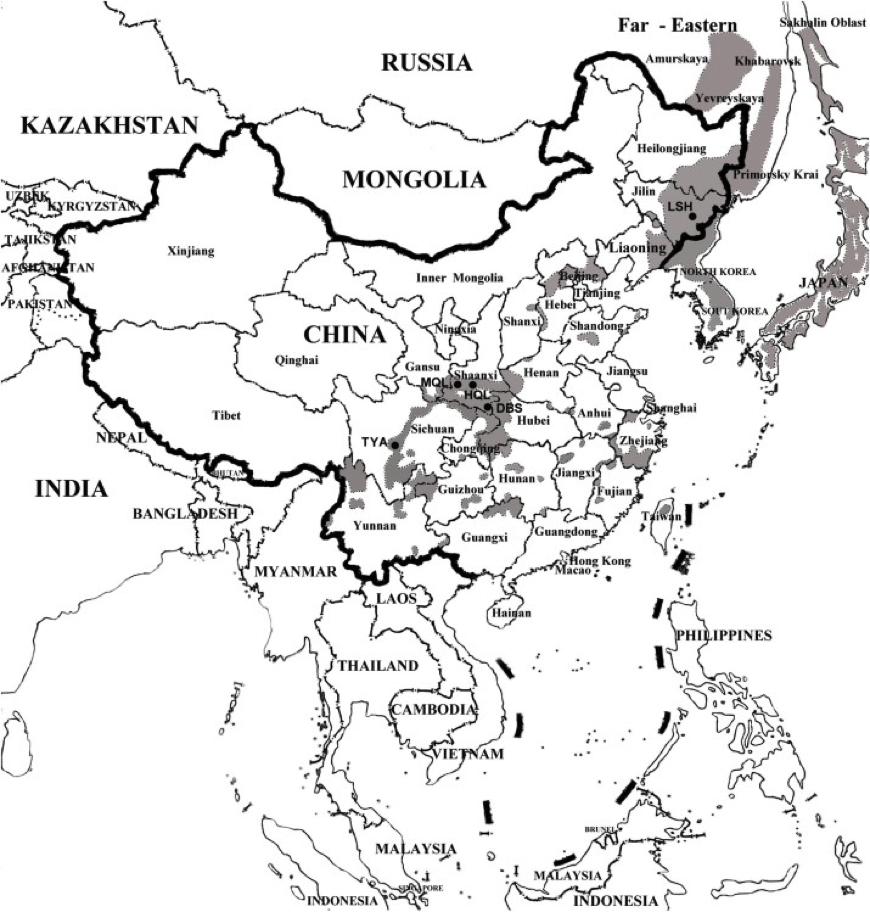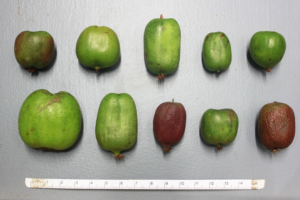Overview of the species
Actinidia arguta (Siebold & Zucc.) Planch. ex Miq., a perennial woody vine native to the temperate forests of eastern and north-eastern Asia, grows endemically in central and northern China, Japan, the Korean peninsula, and eastern Siberia (Kataoka et al. 2010) (Fig 1). The highly diverse kiwifruit, or Chinese Gooseberry, family Actinidiaceae (Huang 2014) consists of more than 50 species, among which A. arguta exhibits the widest native geographic range (Ferguson & Huang 2007). The species was referred to by a variety of common names throughout the 20th century, including hardy kiwi, northern kiwi, dessert kiwi, cocktail kiwi, arctic kiwi, big/little kishmish, bower vine, tara fig, and others (Kabaluk et al. 1997). In this guide, we adopt the emerging convention among producers and marketers worldwide in using the term “kiwiberry” to refer to fruit produced by vines of the species A. arguta.
Along with A. kolomikta and A. polygama, A. arguta is one of only three kiwifruit species noted for their cold-hardiness. Specifically, A. arguta is capable of withstanding temperatures down to -29°F (-30℃) (Latocha 2007) during winter dormancy, making the species well-adapted to many locations within the northeast United States. In comparison, A. kolomikta is hardy to -40°F (-40℃) (Strik 2005) and A. polygama is hardy to -24°F (-31°C) (Chat 1995). (See Appendix V ‘Supplement on Actinidia kolomikta’ for more information about this species.)
Like all kiwifruit species, A. arguta is dioecious, meaning that a given individual vine is either functionally male, bearing exclusively male flowers with no female organs, or functionally female, bearing exclusively female flowers with no viable pollen. Both male and female vines are required to produce fruit (Fig 2); and botanically, the fruits produced are berries, as is true of all Actinidia species.
Kiwiberries are much smaller (~50 berries per pound, 0.5-1.0″ × 1.0-1.5″) than the more familiar fuzzy kiwifruits (~7 berries per pound, 1.5-2.5″ × 2.5-3.0″) (Strik 2005) that dominate the global kiwifruit industry (A. chinensis var. chinensis and A. chinensis var. deliciosa). Because kiwiberries lack the fuzzy outer skin (exocarp) characteristic of their larger, less cold-hardy relatives, the smooth, tender-skinned, grape-sized berries are consumed whole. The smooth, edible skins also make kiwiberries well-suited to a myriad of value-added products, such as jams, cooking additives, and beverages, due to the reduced processing requirement.
Convenient to eat and a versatile value-added ingredient, the kiwiberry is also rightly referred to as a “super-fruit” due to its high nutrient density. Ounce-for-ounce, kiwiberries contain twice the vitamin C of an average orange, 80% of the potassium of a banana, and 1.6 times the dietary fiber of an apple (Table 1). The berries also contain a higher lutein content than nearly all other common fruits; and they are an excellent source of B-complex vitamins, vitamins A and E, and minerals including iron, calcium, and manganese.
Table 1 Some nutritional attributes of kiwiberries (Latocha 2017)
| Nutrient or Vitamin | Reported Value or Range | Unit |
| Potassium | 152.7 – 382 | mg/100 g Fresh Weight (FW) |
| Iron | 0.31 – 1.15 | mg/100 g FW |
| Calcium | 51.5 – 120.1 | mg/100 g FW |
| Manganese | 0.03 -0.24 | mg/100 g FW |
| Zinc | 0.18 – 1.45 | mg/100 g FW |
| Magnesium | 10.0 – 23.2 | mg/100 g FW |
| Vitamin C | 45.4-107.7 | mg/100 g FW |
| Citric acid | 5.75-9.56 | mg/100 g FW |
| β-carotene | 0.29 | mg/100 g FW |
| Lutein | 0.93 | mg/100 g FW |
| Vitamin B1 | 0.01-0.05 | mg/100 g FW |
| Vitamin B2 | 0.02-0.11 | mg/100 g FW |
| Vitamin B3 | 0.50-1.55 | mg/100 g FW |
| Vitamin B5 | 3.80-5.60 | mg/100 g FW |
| Vitamin B6 | 1.10-1.90 | mg/100 g FW |
| Vitamin B8 | 266.0-982.0 | mg/100 g FW |
| Vitamin A | 37.3-84.5 | μg RAE (Retinol activity equivalents)/100 g FW |
| Vitamin E | 4.6 – 5.3 | mg/100 g FW |
| Fiber | 2.9 -4.1% | %FW |
Complementing the nutritional benefits of the kiwiberry is its taste. With a sugar content exceeding that of table grapes and an acidity on par with grapefruit, the smooth-skinned berries possess a pleasantly complex profile, combining banana, floral, and melon aromas with blackcurrant, fruit candy, melon, citrus, and tropical flavors (Matich et al. 2003; Fisk et al. 2006). Even within the relatively narrow collection of kiwiberry cultivars here in the United States, berry size, shape, color, and taste vary widely (Fig 3), representing great opportunity to develop varieties with novel attributes to satisfy consumer preferences.
Fig 1 Map of eastern Asia, showing the natural distribution of Actinidia arguta, in grey. Map credit: Lai et al. 2015
Fig 2 Female (left) and male (right) kiwiberry flowers. Female flowers are identifiable by the presence of a stigma and lack of viable anthers.
Fig 3 An impressive diversity exists among kiwiberries, in terms of shape, color, and flavor.




